Keywords
nutrition- students - knowledge-dietary habits
Introduction
Nutrition is an issue of great academic and public importance, as change in dietary habits could result in a healthier life and longevity [1,2] . Many medical schools have been trying to improve their nutrition education curricula. Some form of nutrition education belongs to the curriculum of most medical schools worldwide [3,4] . However, there is evidence that medical professionals have serious deficits in their nutrition knowledge [5,6] . Even further, health science students do not seem to adopt a healthy eating and questions about their nutrition knowledge and efficacy of nutrition curricula are raised [7,8] . It is generally believed that there is a need for improved teaching of nutrition in medical schools. As shown in previous studies, there is a surprising lack of knowledge in some fundamental areas of nutrition. Sources of monounsaturated fats, effects of low fat diet on triglycerides and HDL, dietary effects on blood cholesterol, are among others , some issues proved to insufficiently known by a considerable percentage of students and specialized physicians as well [5,6] . A questionnaire survey in cardiologists and internists revealed lapses in their nutrition knowledge and, as these specialties are thought to be crucial for prevention policy of Cardio Vascular Disease (CVD), the need for further improving the nutrition knowledge of both medical professionals and general population is compelling [5] . As performance of medical professionals on nutrition issues has been related to their academic and professional experience [5,9] , it seems appropriate to study the performance of medical students across semesters. The goal of the present study was to assess the nutrition knowledge of a nursing students sample regarding to their semester class and to some socioeconomic features. The data presented here come from a questionnaire that was adjunct to a broader one regarding the dietary habits of nursing students. The latter data have been published elsewhere [6] .
Method and Material
The students of the Nursing Department of TEI of Lamia during the time period 05/15/06 -05/26/06 were the sample of the study. Five hundred and six students of both sexes were administered a questionnaire on their dietary habits and their nutrition knowledge. The questionnaire was filled in anonymously, in the presence of a member of the research team and the time required was approximately ten minutes. Eight closed –type questions were included. Knowledge on bread and rusk calories, daily egg consumption impact on blood cholesterol, ferrum content of various foods, Mediterranean Nutrition Pyramid and BMI definition was tested. Neither communication between students was allowed, nor was any further explanation beyond the general instructions given. Only one answer was the permitted.
The right answers are based on fundamental nutrition knowledge published in textbooks [10] . Special notice should be given to question no. 8 (egg consumption), as previous knowledge in this field was rather unclear. Nowadays the egg consumption at this level (to 2 daily) is no further accused of cardiovascular harm in healthy individuals [11,12] .
Statistics was processed with SPSS for windows. The x2 test was used as a –goodness of fit- test, in order to detect differences in the various categories examined. The distribution of correct answers was studied across the semesters as well as in relation to parental educational level and the place of student’s high school. Expected frequency distribution in each category was extracted in accordance with the distribution of the whole sample in the same category. The answers in question 7 were clustered in two groups (all of the above-correct-vs any other answer-wrong). Level of statistical significance was set at 0.05.
Results
In regard to gender 78.3 % ( n=396) were women, whereas 21.7% (n=110) were men. Mean age was 20 ± 0.3 years.Students distribution depending on semester was 13.8% (70) , 17% (86), 14.8% (75), 14.2% (72), 12.9% (65) 13.8% (70) and 13.4% (68) for A, B, C, D, E, F and G semester.
Most students graduated from high schools in cities (38.3%,194) and towns(32.6, 165). 19.2 %(97) and 9.9 %(50) come from townships and villages respectively. Regarding the parental educational level , 53.2% (269) of parents were Junior High School/High School graduates, 27.1% (137) University/College graduates , 19.5 (99) Elementary school graduates and 0.2% (1) illiterate. (Table 1).
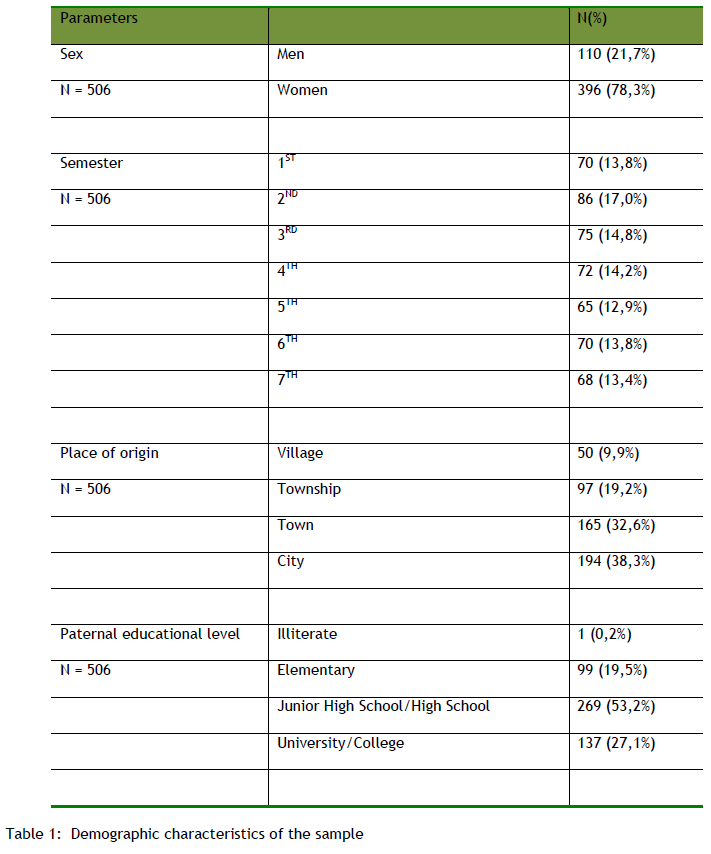
The distribution of answers (total and correct ones)is presented in tables 2 & 3. It is shown that 61,7% (312) did not know that 30 gr of wheat bread give less calories than 30 gr of wheat rusk. Three hundred and thirty two students (65.6%) knew that 30 gr of white bread contain less nutrients than 30 gr of whole bread. Most students 94.7% (479) correctly answered that bad nutrition is a predisposing factor for chronic diseases .Most students were familiar with Mediterrenean dietary pyramid (n=346, 68, 4 %).The BodyMassIndex was known to 331 students ( 65.4%).Half of the students (50,6% n=256) answered correctly which foods contain ferrum.
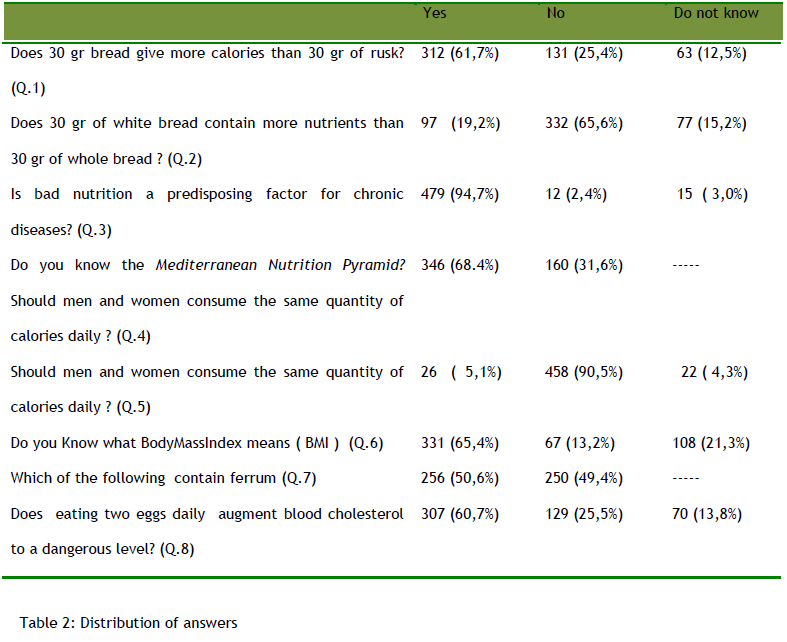
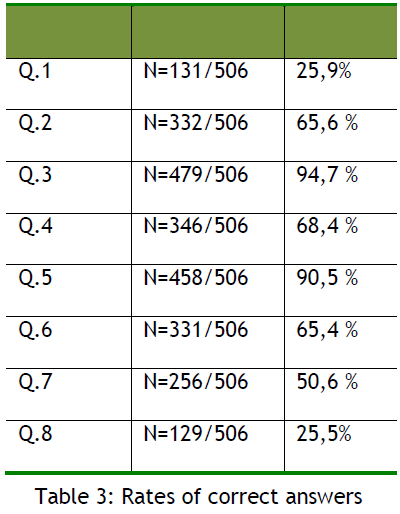
Most students 60,7% (307) believe that eating two eggs daily results in a dangerous increase in blood cholesterol level (the question referred to health individuals
The comparison of answer distribution depending on socioeconomic features are presented in tables 4,5 and 6.According to the data the knowledge of BMI was statistically related to semester, as substantially more than expected students answered correctly in the 6th semester and less than expected did so in the 1st one. Regarding the question no 8., more than expected students gave the right answer in the 1st semester ( p< 0.1).
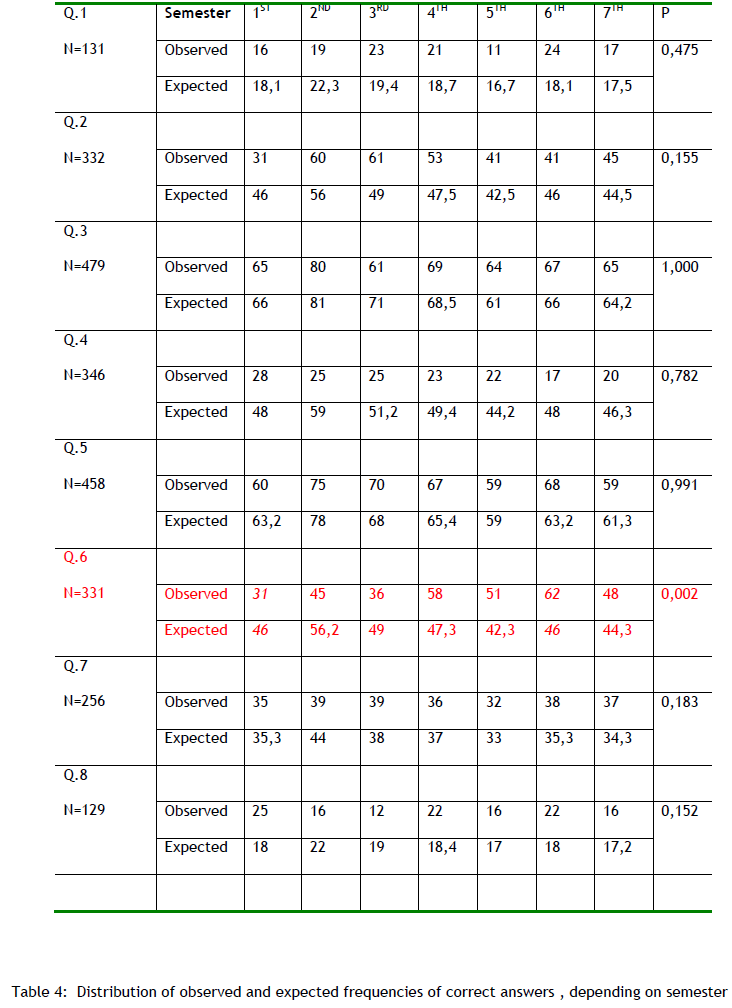
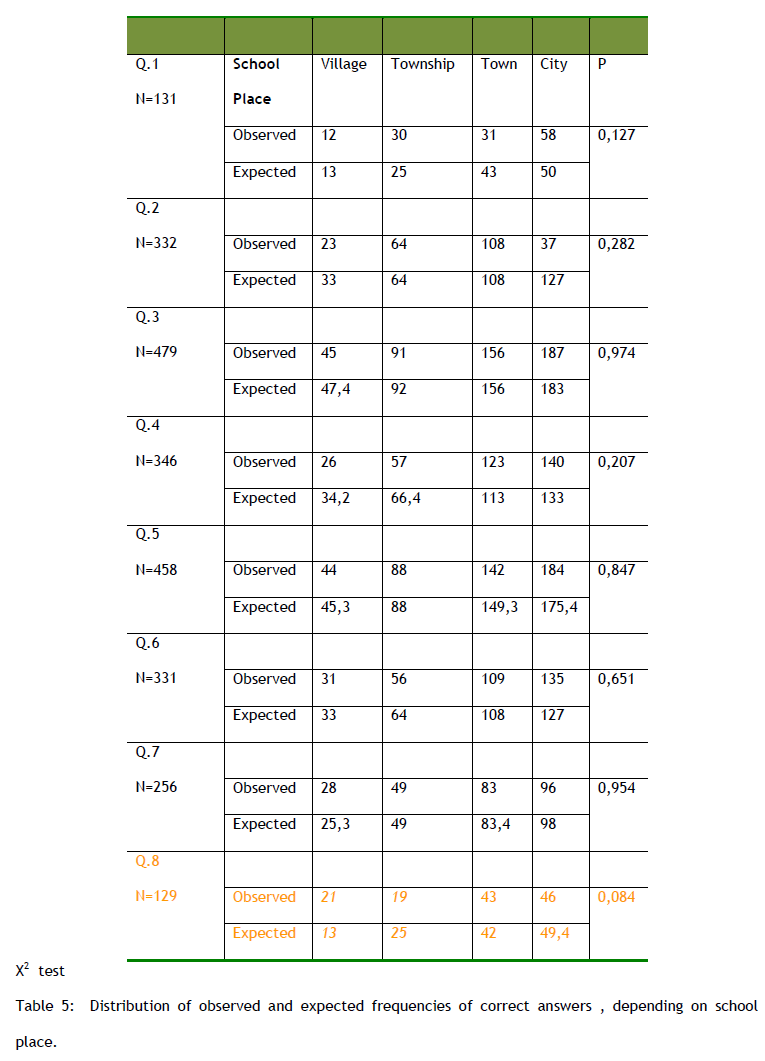
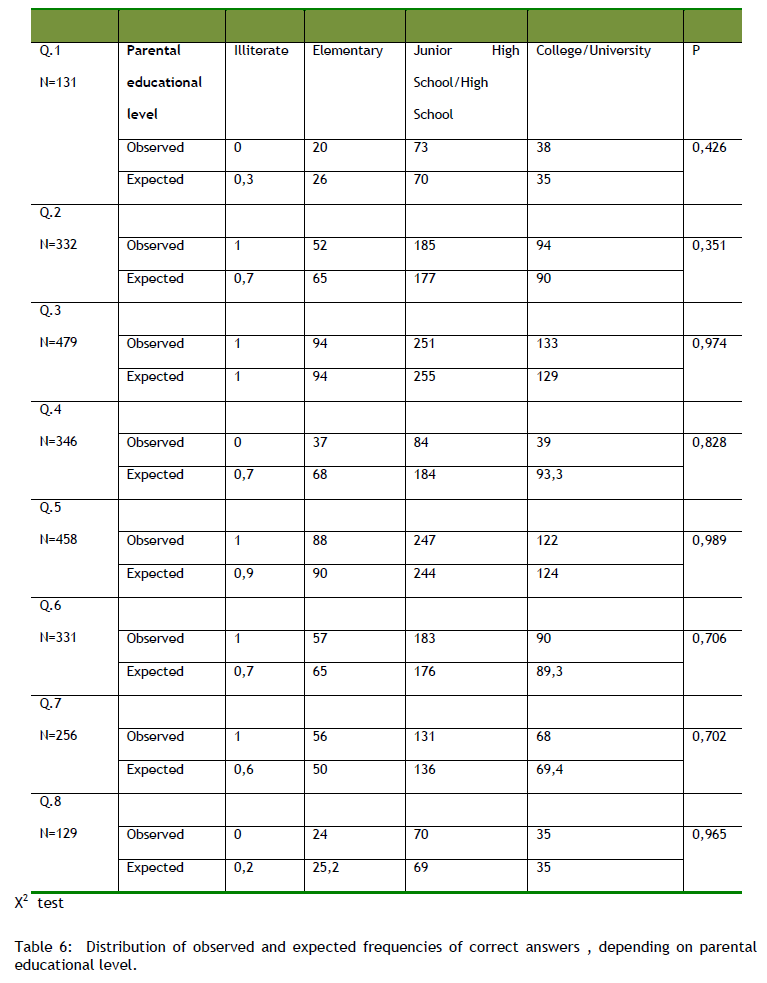
Discussion
Essential nutrition knowledge appeared well established in students of the present study. They are familiar with differences in calories consumption depending on sex and the BMI. However, there are still students that do not answer correctly or declare ignorance, a percentage that approximates 10%, in the above itemsAs shown in other studies as well, there is an increasing knowledge on the bioprotective profile of the traditional Mediterranean diet although there is also a need to revisit the way this knowledge is transferred to the public emphasizing the importance of some neglected food items and nutrients [13,14] . A comprehensive knowledge of food synthesis and preparation is lacking, since scoring is worsening as questions regarding calories comparison or other elements (ferrum) are put forward. These questions demand more profound nutrition knowledge. Rusk is made of dried bread, resulting in more calories for the same weight [10] , whereas ferrum is present in a variety of foods, no matter how absorbable it is. [10] Nonetheless, around fifty percent of the students did not know the broad distribution of ferrum in foods whereas only a quarter of students know that 30 gr of ( wheat ) rusk contain more calories than 30 gr of (wheat)bread. Questions referring to energy density are a somewhat weak link in student’s knowledge. In Makowske’s study , when students are asked about the macronutrient that is the most energy dense, approximately 25 % of first year medical student did not answered correctly [5] .
Knowledge of BMI was related to the semester of attendance the Nursing School, as less than expected students of the first semester were familiar with the term, whereas more than expected students in the sixth semester reported they knew what BMI means. This was the only parameter associated with the semester of studies. No difference was traced in the distributions of the other correct answers in relation to semester, place of high school, paternal educational level. First year students did not do as well as physicians at some nutrition knowledge questionnaires, as shown in the study of Makowsky & Feinman [5] . On the other hand, as no other differences were notified, socioeconomic or family educational discrepancies seem to have no substantial differentiating effect on students nutrition knowledge Moreover, despite the implementation of nutrition education curricula in high schools and universities, students knowledge remains fragmental and the perception of certain diet values is distorted . As a result, many students tend to engage in detrimental health practices and neglect certain food items and nutrients [8] .
The answer to the last question probably reflects a misunderstanding regarding the effects of eggs on blood cholesterol and CVD. It is likely that many medical students and professionals would not know that dietary cholesterol is largely without effect on serum cholesterol [5] . Past findings regarding relationship of eggs and blood cholesterol have been somewhat controversial, since extensive research has not clearly established a link between egg consumption and risk for coronary heart disease or blood cholesterol levels [15] . The Third Report of the National Cholesterol Education Program (NCEP) Expert Panel on Detection, Evaluation, and Treatment of High Blood Cholesterol in Adults (Adult Treatment Panel III) recommended that at most 2 egg yolks should be consumed per week [16] . However, further studies failed to detect changes in serum total cholesterol concentration when egg was added to diets that already contained moderate amounts of cholesterol [17,18] . First, a conservative estimate suggests that only 30% of the population would respond to dietary cholesterol. (hyperresponders).The rest are considered as hyporesponders. The first exhibit about 15 % increase in LDL cholesterol, while the latter experiences a mild increase or no alterations in plasma cholesterol concentrations when challenged with high amounts of dietary cholesterol [12] . Diverse healthy populations experience no risk in developing coronary heart disease by increasing their intake of cholesterol but, in contrast, they may have multiple beneficial effects by the inclusion of eggs in their regular diet. Nonetheless, the effect of the egg cholesterol is hard to resolve against the background of other sources of cholesterol in the diet. A study that examined the intake of 117,000 nurses and health professionals over a 14-y period, found no difference in the relative risk for CoronaryHeartDisease between those who consumed less than one egg a week and those who ate more than one egg a day [17] . When dietary confounders are considered, no association between egg consumption at levels of 2 eggs daily and coronary heart disease or elevation of plasma cholesterol is established and if any, it does not reach dangerous levels [11] . If limiting egg consumption may have some health benefits, these seem to be restricted to women in geographic areas where egg consumption makes a relatively large contribution to total dietary cholesterol intake [18] .
The knowledge that a bad nutrition contributes to the development of chronic disease is well established in the students. Indeed, detrimental nutrition habits and obesity are associated with severe chronic diseases of metabolic origin, CVD, osteoporosis or even cancer [19,20] . Obesity has grown at an alarming rate, and concomitant with this rise there is an increasing prevalence of metabolic risk factors in young children and adolescents [21] .
Undoubtedly nursing and medical school curricula are very dense in content, including nutrition issues. However, the way the dietary guidelines have been perceived by both the public and in certain cases by the scientific community may be oversimplified. “What to teach” in nutrition programs is an emerging major question nowadays [5,22] .Many papers have been written on the necessity, and the difficulty at the same time in implementing , improvements in teaching nutrition in health science departments [23,24] . Inflexibility in the curriculum and inability to define the proper aspects of the subjects to be taught are thought as the main obstacles [5] . A comprehensive approach to recent advances in dietary data and the recording of students’ needs will allow the improvement of nutrition knowledge and contribute to the adoption of healthy dietary habits by both medical professionals and general public.
3421
References
- Together for Health : Plenary vote outcome https:// www.european-nutrition.org/record.jsp?type=news&ID=98 ( accessed : 02/17/09)
- Ginter E. Vegetarian diets, chronic diseases and longevity. BratislLekListy. 2008;109(10):463-6.
- Cooksey K, Kohlmeier M, Plaisted C, Adams K,Zeisel SH. Getting nutrition education into medical schools: a computer-based approach. Am J ClinNutr. 2000;72:868S?76S
- Lo C. Integrating nutrition as a theme throughout the medical school curriculum. Am J ClinNutr. 2000;72:882S?9S
- Makowske M, Feinman R. Nutrition education: a questionnaire for assessment and teaching. Nutr J. 2005; 4: 2.
- Flynn M, Sciamanna C, Vigilante, K. Inadequate physician knowledge of the effects of diet on blood lipids and lipoproteins. Nutr J. 2003;2:19.
- Yfanti E, Tsiriga S, Tiniakou I, Yfantis A, KoutisCh ,Noula M. Dietary habits among Nursing Students of TEI of Lamia. Medical Chronicles .2008 ;31: 426-432.
- Bayona-Marzo I, Navas-C?mara FJ, Fern?ndez de Santiago FJ, et al. Eating habits in physical therapy students. Nutr Hosp. 2007; 22(5):573-7.
- Taren D, Thomson C, Koff NA, Gordon PR, Marian MJ, Bassford TL et al. Effect of an integrated nutrition curriculum on medical education, student clinical performance, and student perception of medical-nutrition training . American Journal of Clinical Nutrition 2001; 73 6 : 1107-1112.
- Kritchevsky SB, Kritchevsky D. Egg consumption and coronary heart disease: an epidemiologic overview.J Am CollNutr. 2000;19(5 Suppl):549S-555S.
- Fernadez ML. Dietary cholesterol provided by eggs and plasma lipoproteins in healthy populations. CurrOpinClinNutrMetab Care 2006;9:8-12.
- Manios Y, Detopoulou V, Visioli F, Galli C. Mediterranean diet as a nutrition education and dietary guide: misconceptions and the neglected role of locally consumed foods and wild green plants. Forum Nutr. 2006;59:154-70.
- Tavelli S, Beerman K, Shultz JE, Heiss C. Sources of error and nutritional adequacy of the food guide pyramid. J Am Coll Health. 1998; 47(2):77-82.
- Hu FB, Stampfer MJ, Rimm EB, Manson JE, Ascherio A, Colditz GA et al. A prospective study of egg consumption and risk of cardiovascular disease in men and women. JAMA 1999;281:1387?94.
- Expert Panel on Detection, Evaluation, and Treatment of High Blood Cholesterol in Adults. Executive Summary of The Third Report of The National Cholesterol Education Program (NCEP) Expert Panel on Detection, Evaluation, and Treatment of High Blood Cholesterol in Adults (Adult Treatment Panel III). JAMA 2001;285:2486?9.
- Herron K, Fernandez M. Are the Current Dietary Guidelines Regarding Egg Consumption Appropriate?. The American Society for Nutritional Sciences J. Nutr. 2004, 134:187-190.
- Yasuyuki Nakamura, Tomonori Okamura, Shinji Tamaki, Takashi Kadowaki, et al. Egg consumption, serum cholesterol, and cause-specific and all-cause mortality: the National Integrated Project for Prospective Observation of Non-communicable Disease and Its Trends in the Aged, 1980 (NIPPON DATA80). American Journal of Clinical Nutrition, 2004;80:58-63.
- Klein S, Burke LE, Bray GA, Blair S, Allison DB, Pi-Sunyer X, et al.. Clinical implications of obesity with specific focus on cardiovascular disease: a statement for professionals from the American Heart Association Council on Nutrition, Physical Activity, and Metabolism: endorsed by the American College of Cardiology Foundation. Circulation. 2004;110:2952?2967
- BarnessL.Chronic disease from early malnutrition: Fetal and Pediatric Pathology,2002; 21( 2) : 87 - 92 .
- Sacheck J. Pediatric obesity: an inflammatory condition. JPEN J Parenter Enteral Nutr. 2008; 32(6):633-7.
- Adams KM, Lindell KC, Kohlmeier M, Zeisel SH. Status of nutrition education in medical schools. Am J ClinNutr. 2006;83(4):941S-944S.
- Darer JD, Hwang W, Pham HH, Bass EB, Anderson G. More training needed in chronic care: a survey of US physicians. Acad Med2004;79 :541 ?8.
- Babatsikou F, KoutisCh, Iordanou P, Nestor A, Mouriki P. Students? attitudes regarding fasting and nutrition . Nosileftiki 2001; 40: 29-104.











